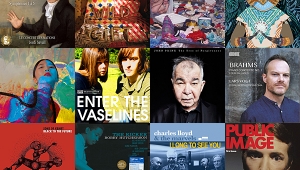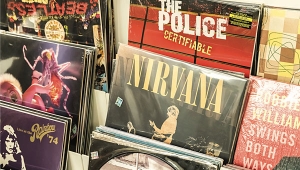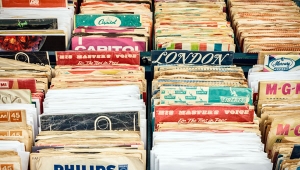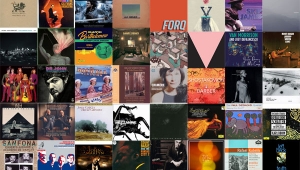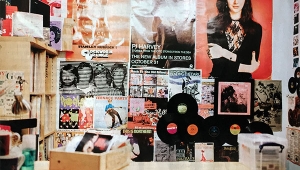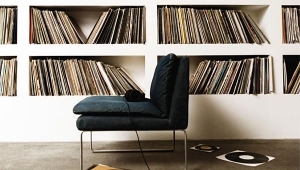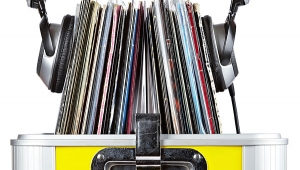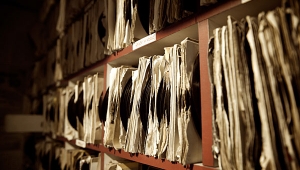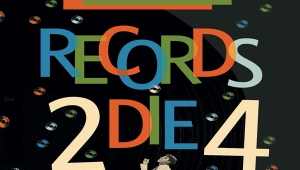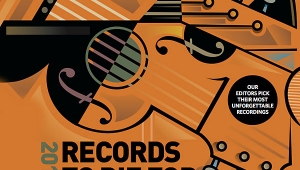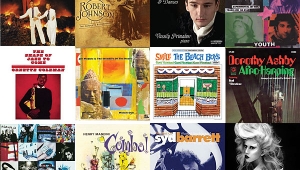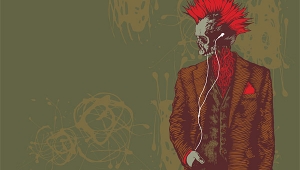| Columns Retired Columns & Blogs |
1997 Records To Die For Page 9
Robert Levine
ROSSINI: Gugliemo Tell
Sherrill Milnes, Tell; Lucinao Pavarotti, Arnold; Mirella Freni, Matilde; Nicolai Ghiaurov, Gualtiero; others; Ambrosian Opera Chorus, National Philharmonic Orchestra, Riccardo Chailly
London 417 154-2 (4 CDs only). 1978-79. James Mallinson, Michael Haas, prods. ADD. TT: 3:54:44
It doesn't get much better than this: Rossini's final stage work in all its glory (albeit in Italian translation---only the fussy and the French would complain), recorded in 1978-79, when all the principals were at their peak. The sound is big and roomy (as is the opera)---Decca/London at its best---and this set is proof that at one time Pavarotti actually had everything one could ask for in a tenor. Freni is no less fine, singing with absolute abandon and comfort, and Milnes, too, is at his most heroic and likeable. Chailly makes the action mean something, and orchestra and chorus are super.
THE AGE OF BEL CANTO
Arias, duets, and trios by Auber, Bellini, Donizetti, Handel, Mozart, Rossini, Verdi, Weber, others
Joan Sutherland, soprano; Marilyn Horne, mezzo; Richard Conrad, tenor; New Symphony Orchestra of London, London Symphony Orchestra & Chorus, Richard Bonynge
London 448 594-2 (2 CDs only). 1963. Christopher Raeburn, prod. ADD. TT: 109:10
This set changed the way I listened to opera. I had had no idea that voices could leap, lean, plead, blend, swoon, and startle as they do here. Yes, I'd heard pyrotechnics before, but the embellishments, the tours de force, the sheer beauty of sound I discovered here simply dazed me. Recorded in 1963, Sutherland still (occasionally) pronounced consonants, and Horne was a young filly. It was clear even then that the lighter-than-air Conrad was a tenor for recording purposes only---but his mellowness is a real plus. And now that the sound, previously frequently overloaded, has been cleaned up, there's nothing to stop this from entering the pantheon.

Thomas J. Norton
SAINT-SAËNS: Oratorio de Noel
RESPIGHI: Lauda per la Nativita del Signore
Britt-Marie Aruhn, soprano; Anne Sofie von Otter, mezzo; Ing-Mari Landin, alto; Erland Hagegard, tenor; Ulf Lundmark, baritone; Mikaeli Chamber Choir, Anders Eby
Proprius PRCD 9057 (CD only). 1981. Karl-Göran Linzander, prod.; Bertil Alving, eng. ??? TT: 57:43
In the late '70s and early '80s, a series of remarkable choral recordings were released by Proprius, a small Swedish label. The effort here dates from 1981. It has long been a favorite of mine on LP, and while this CD does not erase the memory of that accomplishment, it does substantial justice to the superb accomplishment of engineer Bertil Alving---who was responsible for the high sound quality attained on most of those Proprius choral triumphs. Those familiar only with Saint-Saëns's bombastic "Organ Symphony" and perhaps Samson et Dalila will be astonished at the beauty and subtlety of his writing here for chorus, soloists, organ, and strings. The interplay is superbly rendered in the recording, which also convincingly captures the acoustics of St. John's Church in Stockholm, where it was recorded. The Respighi work that closes out this CD is a fine bonus, though the Saint-Saëns is, for me, the real attraction here. Both works are technically "Christmas music," but you'll be just as happy to hear them in July as in December.
GILBERT & SULLIVAN: Here's a Howdy Do!
The King's Singers
RCA 61885-2 (CD only). 1993. Daryl Runswick, prod.; David Jacob, eng. DDD. TT: 54:52
Here's a chancy recommendation. Both The King's Singers and Gilbert & Sullivan provoke extreme reactions, pro and con. But if you have a weakness for either of them---and I do for both---you'll want this recording. G&S purists will likely blanche at some of the arrangements, but it's hard to deny that they bring new life to material that more than occasionally suffers from an excess of "tradition." Nevertheless, the music here is timeless, and G&S's social satire holds up as well today as ever. The recording is first-rate: clean, open, dimensional, and detailed. Unlike most King's Singers recordings, there is subtle instrumental accompaniment in several of the tracks. Both instruments and voices are well served. If you're an old G&S hand, this recording will refresh your palate. If you don't know them from Ren and Stimpy, well, here's a howdy do.
DEAD CAN DANCE: Into the Labyrinth
4AD 45384-2 (CD only). 1994. Brendan Perry, prod., eng. AAD. TT: 55:24
I don't know, exactly, how to characterize this music. It certainly isn't rock, and you'll find it hard to boogie to. I've described it to friends as "Middle-East Celtic," which seems to fit. There are lush, brogue-tinged vocals here, but much of the music seems to come right out of an Istanbul bazaar---certainly a combination I've never heard before. While much of the writing here is Dead Can Dance's own, there are notable exceptions, particularly Bertoldt Brecht's lyrics to "How Fortunate the Man with None." The recording venue---Quivvy Church---complements the vocals and instrumentals perfectly. The ambience of the Church environment sounds like the real thing---though it isn't always possible to tell for certain today. The sound is simultaneously rich and detailed; this does not sound at all like your typical over-engineered pop mix. Into the Labyrinth is a strange yet strangely compelling recording. (XVII-7, XX-2)

Dan Ouellette
MILES DAVIS: Kind of Blue
Miles Davis, trumpet; Bill Evans, Wynton Kelly, piano; John Coltrane, tenor sax; Julian "Cannonball" Adderley, alto sax; Paul Chambers, bass; James Cobb, drums
Columbia CK 40579 (CD only). 1959/1987. Teo Macero, prod., digital remix prod.; Larry Keyes, digital remix eng. ??? TT: 45:09
Not only does Miles Davis's pensive masterpiece Kind of Blue feature some of the best-known, instantly recognizable tunes in jazz, it also boasts one of the greatest all-star ensembles---with an incredible front line of the leader joined by John Coltrane, Cannonball Adderley, and Bill Evans---to ever congregate and collectively improvise in the studio. This is a priceless collection, from Evans's short piano intro and bassist Paul Chambers's melodic cue in the opening measures of "So What," to Davis's yearning trumpet lines and Coltrane's tenor-sax soul on the alluring end piece, "Flamenco Sketches." What's even more remarkable is the fact that Davis conceived the compositional sketches only a few hours before the tapes rolled. (XV-2, XIX-2)
JONI MITCHELL: Blue
Reprise 2038-2 (CD only). 1971/1996. Henry Lewy, eng. AAD. TT: 36:14
A little over a decade after Davis' disc, pop singer-songwriter Joni Mitchell recorded her bittersweet magnum opus, Blue. With her guitar, piano, and dulcimer providing the bulk of the spare instrumentation, Mitchell delivers a deeply honest, richly poetic collection of tunes about heartsick romance, melancholy memories, and longings for freedom. She sings in the title number that "songs are like tattoos." Likewise, her melodies here---prime examples are "Carey," "California," and "River"---are indelible. Plus, she offers such poignantly memorable lyrics (on the subjects of regret and addictive love, respectively) as "I wish I had a river I could skate away on" and "I could drink a case of you / And I would still be on my feet." The only dated moment in the entire collection is Mitchell singing "I'll even kiss a Sunset pig" ("California"). (XIV-1)

ROSSINI: Gugliemo Tell
Sherrill Milnes, Tell; Lucinao Pavarotti, Arnold; Mirella Freni, Matilde; Nicolai Ghiaurov, Gualtiero; others; Ambrosian Opera Chorus, National Philharmonic Orchestra, Riccardo Chailly
London 417 154-2 (4 CDs only). 1978-79. James Mallinson, Michael Haas, prods. ADD. TT: 3:54:44
It doesn't get much better than this: Rossini's final stage work in all its glory (albeit in Italian translation---only the fussy and the French would complain), recorded in 1978-79, when all the principals were at their peak. The sound is big and roomy (as is the opera)---Decca/London at its best---and this set is proof that at one time Pavarotti actually had everything one could ask for in a tenor. Freni is no less fine, singing with absolute abandon and comfort, and Milnes, too, is at his most heroic and likeable. Chailly makes the action mean something, and orchestra and chorus are super.
THE AGE OF BEL CANTO
Arias, duets, and trios by Auber, Bellini, Donizetti, Handel, Mozart, Rossini, Verdi, Weber, others
Joan Sutherland, soprano; Marilyn Horne, mezzo; Richard Conrad, tenor; New Symphony Orchestra of London, London Symphony Orchestra & Chorus, Richard Bonynge
London 448 594-2 (2 CDs only). 1963. Christopher Raeburn, prod. ADD. TT: 109:10
This set changed the way I listened to opera. I had had no idea that voices could leap, lean, plead, blend, swoon, and startle as they do here. Yes, I'd heard pyrotechnics before, but the embellishments, the tours de force, the sheer beauty of sound I discovered here simply dazed me. Recorded in 1963, Sutherland still (occasionally) pronounced consonants, and Horne was a young filly. It was clear even then that the lighter-than-air Conrad was a tenor for recording purposes only---but his mellowness is a real plus. And now that the sound, previously frequently overloaded, has been cleaned up, there's nothing to stop this from entering the pantheon.
Thomas J. Norton
SAINT-SAËNS: Oratorio de Noel
RESPIGHI: Lauda per la Nativita del Signore
Britt-Marie Aruhn, soprano; Anne Sofie von Otter, mezzo; Ing-Mari Landin, alto; Erland Hagegard, tenor; Ulf Lundmark, baritone; Mikaeli Chamber Choir, Anders Eby
Proprius PRCD 9057 (CD only). 1981. Karl-Göran Linzander, prod.; Bertil Alving, eng. ??? TT: 57:43
In the late '70s and early '80s, a series of remarkable choral recordings were released by Proprius, a small Swedish label. The effort here dates from 1981. It has long been a favorite of mine on LP, and while this CD does not erase the memory of that accomplishment, it does substantial justice to the superb accomplishment of engineer Bertil Alving---who was responsible for the high sound quality attained on most of those Proprius choral triumphs. Those familiar only with Saint-Saëns's bombastic "Organ Symphony" and perhaps Samson et Dalila will be astonished at the beauty and subtlety of his writing here for chorus, soloists, organ, and strings. The interplay is superbly rendered in the recording, which also convincingly captures the acoustics of St. John's Church in Stockholm, where it was recorded. The Respighi work that closes out this CD is a fine bonus, though the Saint-Saëns is, for me, the real attraction here. Both works are technically "Christmas music," but you'll be just as happy to hear them in July as in December.
GILBERT & SULLIVAN: Here's a Howdy Do!
The King's Singers
RCA 61885-2 (CD only). 1993. Daryl Runswick, prod.; David Jacob, eng. DDD. TT: 54:52
Here's a chancy recommendation. Both The King's Singers and Gilbert & Sullivan provoke extreme reactions, pro and con. But if you have a weakness for either of them---and I do for both---you'll want this recording. G&S purists will likely blanche at some of the arrangements, but it's hard to deny that they bring new life to material that more than occasionally suffers from an excess of "tradition." Nevertheless, the music here is timeless, and G&S's social satire holds up as well today as ever. The recording is first-rate: clean, open, dimensional, and detailed. Unlike most King's Singers recordings, there is subtle instrumental accompaniment in several of the tracks. Both instruments and voices are well served. If you're an old G&S hand, this recording will refresh your palate. If you don't know them from Ren and Stimpy, well, here's a howdy do.
DEAD CAN DANCE: Into the Labyrinth
4AD 45384-2 (CD only). 1994. Brendan Perry, prod., eng. AAD. TT: 55:24
I don't know, exactly, how to characterize this music. It certainly isn't rock, and you'll find it hard to boogie to. I've described it to friends as "Middle-East Celtic," which seems to fit. There are lush, brogue-tinged vocals here, but much of the music seems to come right out of an Istanbul bazaar---certainly a combination I've never heard before. While much of the writing here is Dead Can Dance's own, there are notable exceptions, particularly Bertoldt Brecht's lyrics to "How Fortunate the Man with None." The recording venue---Quivvy Church---complements the vocals and instrumentals perfectly. The ambience of the Church environment sounds like the real thing---though it isn't always possible to tell for certain today. The sound is simultaneously rich and detailed; this does not sound at all like your typical over-engineered pop mix. Into the Labyrinth is a strange yet strangely compelling recording. (XVII-7, XX-2)
Dan Ouellette
MILES DAVIS: Kind of Blue
Miles Davis, trumpet; Bill Evans, Wynton Kelly, piano; John Coltrane, tenor sax; Julian "Cannonball" Adderley, alto sax; Paul Chambers, bass; James Cobb, drums
Columbia CK 40579 (CD only). 1959/1987. Teo Macero, prod., digital remix prod.; Larry Keyes, digital remix eng. ??? TT: 45:09
Not only does Miles Davis's pensive masterpiece Kind of Blue feature some of the best-known, instantly recognizable tunes in jazz, it also boasts one of the greatest all-star ensembles---with an incredible front line of the leader joined by John Coltrane, Cannonball Adderley, and Bill Evans---to ever congregate and collectively improvise in the studio. This is a priceless collection, from Evans's short piano intro and bassist Paul Chambers's melodic cue in the opening measures of "So What," to Davis's yearning trumpet lines and Coltrane's tenor-sax soul on the alluring end piece, "Flamenco Sketches." What's even more remarkable is the fact that Davis conceived the compositional sketches only a few hours before the tapes rolled. (XV-2, XIX-2)
JONI MITCHELL: Blue
Reprise 2038-2 (CD only). 1971/1996. Henry Lewy, eng. AAD. TT: 36:14
A little over a decade after Davis' disc, pop singer-songwriter Joni Mitchell recorded her bittersweet magnum opus, Blue. With her guitar, piano, and dulcimer providing the bulk of the spare instrumentation, Mitchell delivers a deeply honest, richly poetic collection of tunes about heartsick romance, melancholy memories, and longings for freedom. She sings in the title number that "songs are like tattoos." Likewise, her melodies here---prime examples are "Carey," "California," and "River"---are indelible. Plus, she offers such poignantly memorable lyrics (on the subjects of regret and addictive love, respectively) as "I wish I had a river I could skate away on" and "I could drink a case of you / And I would still be on my feet." The only dated moment in the entire collection is Mitchell singing "I'll even kiss a Sunset pig" ("California"). (XIV-1)
- Log in or register to post comments

